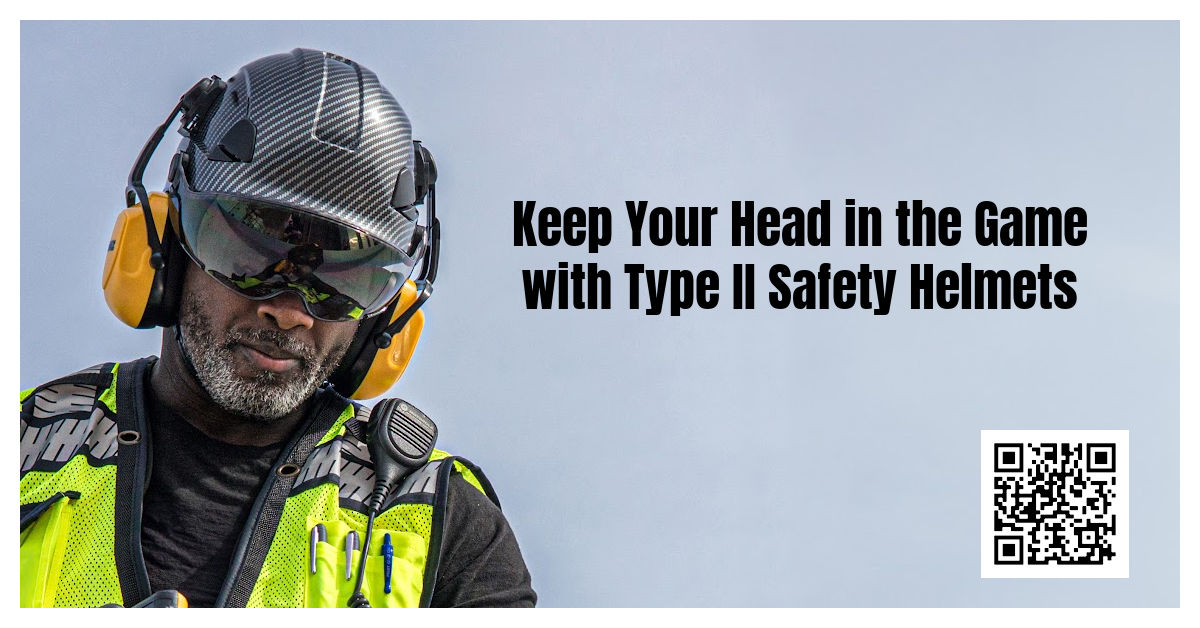Traumatic Brain Injuries (TBIs), including concussions, skull fractures, brain hemorrhages, head bruises, and hematoma occur at many industrial job sites. But which industry is at the very top of the TBI list?
According to the CDC, the “construction industry has the greatest number of fatal and nonfatal traumatic brain injuries among U.S. workplaces.” Since Construction Safety Week is in May, now is a good time to address how Type II safety helmets provide a broader range of protection to help reduce head trauma among construction workers.
Falls Make Up Almost 35 Percent of all Construction Accidents
Although numerous risks co-exist at construction jobsites, falls make up about 35 percent of all construction accidents. According to OSHA, “65 percent of the construction industry works on scaffolds,” so construction workers are at high risk for TBIs and their life-threatening or life-long consequences.
Harnesses, guardrail systems, and personal fall arrest systems are key pieces of conventional fall protection when people are working six feet or more above a lower level. This type of PPE helps prevent the fall from happening. However, if a worker slips, trips, falls or receives a blow to the top of the head, the proper head protection is required to help prevent injury.
Safeguarding the Skull and Gray Matter
Within the domain of safety gear, few items are as crucial and essential as hard hats. These iconic symbols of safety protect the most important part of the body: the head and brain. Many styles of head protection exist to mitigate different risks. To choose what’s best for your job site, let’s review the two primary types of hard hats and the ANSI designations that define a hard hat’s ability to withstand electrical shock.
Which Type is Right for Your Job Site? Type I or Type II?
Hard hat impact protection falls into two primary categories: Type I and Type II.
Type I hard hats, which are currently the most common type of head protection at job sites, reduce forces of impact from a blow to the top of the head.
Example: A worker on scaffolding accidentally drops a hammer or tape measure and it lands on a worker below. If the worker below is wearing a Type I hard hat, it will provide impact protection from the blow to the top of the worker’s head.
Type II hard hats provide a broader shield, defending workers against side blows and off-center impacts to the top, front, and back of the head.
Example: A worker is climbing down a 6’ step ladder. He oversteps, misses a rung, and accidentally falls backward. A Type II safety helmet is best for this situation since it offers multi-directional protection. With slips, trips, and falls, you never know how a person will land. He could land on his back, his side, or even hit head first.
If slips, trips, and falls or falling from heights are risks at your construction site, a Type II safety helmet is your type!
Hard Hat Electrical Performance
According to ANSI/ISEA Z89.1-2014 standards, hard hat electrical performance is divided into three categories: Class E, Class G, and Class C. These class designations denote the hard hat's ability to withstand electrical shock.
- Class E (Electrical): Built to withstand up to 20,000 volts of electricity, Class E non-vented hard hats provide the best safety solution for electrical work environments. They can also be used in Class G situations, making them a versatile choice when you have multiple electrical risks at a job site.
- Class G (General): With a capacity to endure 2,200 volts of electricity, Class G non-vented hard hats provide reliable defense in general industrial settings.
- Class C (Conductive): Lacking electrical insulation, Class C hard hats offer no protection against contact with electrical conductors. They are unsuitable and noncompliant for environments with electrical hazards. However, Class C hard hats and helmets offer impact protection and are often vented for better breathability to increase worker comfort.
The Evolution in Head Protection: The Rise of Safety Helmets
For over a century, traditional Type 1 hard hats reigned supreme as the favored emblem of protection against head injuries. Construction workers developed emotional attachments to them and personalized them with stickers, turning these hard hats, whether full brim or cap style, into a prized possession at the construction site, similar to a favorite pair of broken-in blue jeans or well-worn leather boots.
Since Type 1 hard hats were not designed to protect against off-center angled impacts to the top, back and side of the head, too many TBIs surfaced at construction sites. Why? Because angled impacts are how most head injuries occur, leading “to over half of fatal work-related TBIs,” according to a 2016 NIOSH study.
Over time, ideas evolve, innovations take root, and new PPE solutions emerge, like Type II safety helmets. These modern-day helmets, which are shaped similarly to climbing-style helmets, are a superior alternative, offering comprehensive protection for the entire head. Recognizing the importance of this evolution, the Occupational Safety and Health Administration (OSHA) issued a Safety and Health Information Bulletin on Nov. 22, 2023, shedding light on the key advantages of safety helmets over traditional hard hats.
Type II Recommended Usage
Recognizing the critical role of safety helmets in promoting workplace safety, OSHA recommends Type II protection in a variety of scenarios, including:
- Construction sites, especially those with high risks of falling objects and/or slips, trips, and falls.
- The oil and gas industry where workers face multiple hazards often requiring Type II head protection with integrated eye and face protection.
- Working from heights, including workers on ladders, scaffolding, rooftops, and more.
- For electrical work or proximity to electrical hazards (Note: Vented hard hats or safety helmets cannot be used for electrical work.)
- Instances where regulations or industry standards mandate their use.
A Proactive Approach to Embracing Change
As NetPlus distributors navigate the ever-evolving landscape of safety equipment, integrating Type II safety helmets into their portfolios offers a proactive approach to embracing change.
Recognizing the shifting paradigms in workplace safety, the adoption of Type II safety helmets will allow NetPlus distributors to stay ahead of industry standards, meet the diverse needs of customers, and demonstrate their dedication to prioritizing the well-being and protection of workers across various sectors.
Discover a new Type II—Learn more about the new DEWALT® DPG22 Safety Helmet
The new DEWALT® DPG22 Type II safety helmet and accessories will help NetPlus distributors reach new customers and build stronger relationships with existing ones. By keeping up with the trend of using more advanced Type II safety helmets instead of traditional hard hats, NetPlus distributors can tap into growing market demand, which will keep their businesses growing steadily.
More importantly, NetPlus distributors will help reduce the number of TBIs negatively impacting the construction industry. That’s a noble thing to accomplish because a traumatic brain injury can easily become a life-changing event, for both the injured and their loved ones. Irreparable damage can occur in an instant and leave behind dramatic consequences that could negatively impact the construction worker’s employment and lifestyle.
Our brain controls our speech, motor skills, nervous system, thoughts, and personality. Being such a source of life, why would anyone ever choose not to protect it better with the adoption of Type II head protection?





